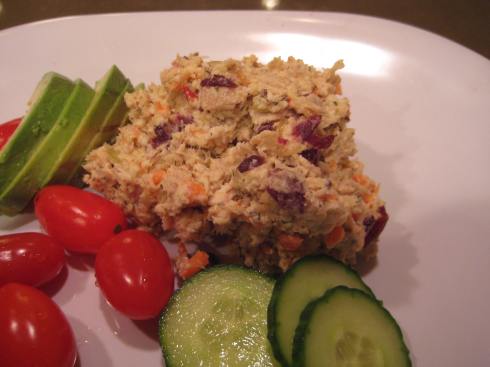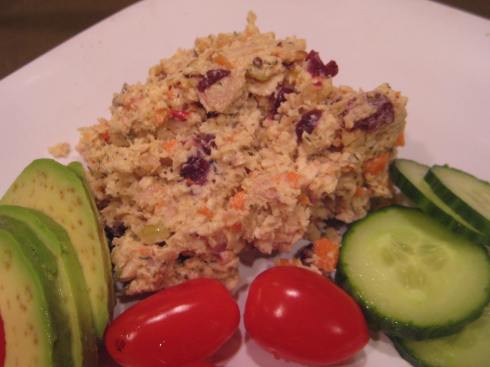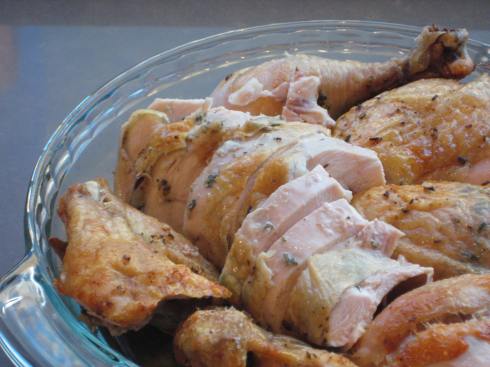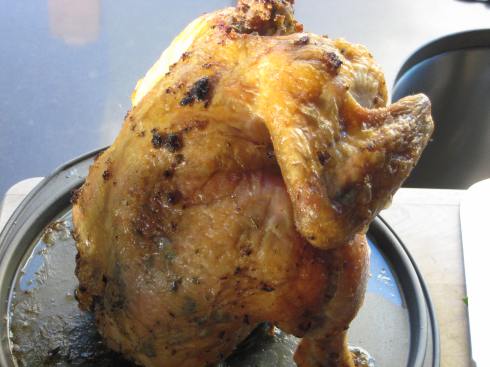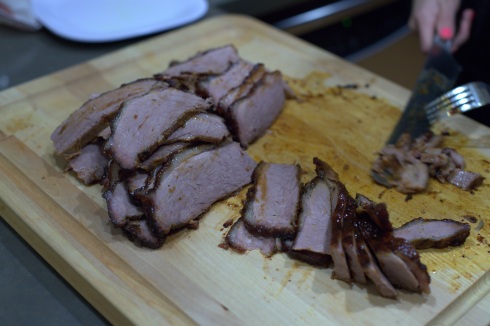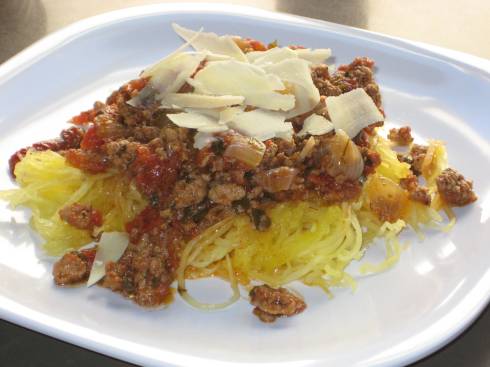You are currently browsing the category archive for the ‘Main Dish’ category.
Chicken salad is something I make often. It’s easy, tasty and the ingredients are readily available. I like that it has fruit and little bits of sweetness even though it’s a savory dish. I usually eat a scoop of this all by itself but also serve it along with veggies or on top a bed of greens. It’s a go-to lunch item but I’ve also made it for company to glowing reviews. If you fancy, you can swap out the cranberries for other dried fruit (raisins are a favorite), add some walnuts or pumpkin seeds, use celery instead of carrots.
Apple Cranberry Chicken Salad
Serves 4
1 pound cooked chicken
1 medium to large apple (I like Fuji but any variety will do)
1 medium carrot
1/2 cup dried cranberries
2 – 3 tablespoons mayonnaise
1 teaspoon grainy mustard
1 – 2 teaspoons TJ’s 21 Seasoning Salute (or other herb mix)
1 teaspoon dried dill
Salt and pepper
- Cut up the cooked chicken, apple and carrot into pieces that are roughly the same size and place in the food processor and pulse. Process until everything looks crumbly.
- Add the remaining ingredients and process just until everything is well mixed.
- Season with salt and pepper to taste.
- Serve with a salad or raw veggies.
Once you see the photo that follows, you will think I am totally corny for the naming the title of this post. The truth is, though, that this is just straight up, good roast chicken. I debated whether to even post the recipe since it’s so straight forward and simple and so many people already know how to roast a chicken. But if you are one of those who could use a little help, read on.
I used to be a huge fan of the rotisserie chicken at Costco. It was so convenient to stop in after work, pick one up and have dinner ready in no time. The chicken was always tender and flavorful and I wish I knew what Costco uses to season it. The best part was how cheap it was – you could get several meals for two people out of one bird for less than $5. But cheap meat probably isn’t the healthiest kind, so now I make my own. It’s easy to do, doesn’t require much preparation and the cooked chicken can be used in so many different ways. After a meal of roast chicken, I use the leftovers for chicken salad, throw it in a frittata, add it to some lettuce wraps, make soup with it, or just eat it cold out of the fridge. It makes such a regular appearance in my kitchen that, like other things I cook a lot, I don’t really measure anything out any more. Honestly, it’s tough to mess this one up but I have provided some guidelines on the ingredients.
I prefer to roast a whole chicken, as opposed to one that is cut up, because you get more flavor with a whole bird. The skin and bones also keep the chicken from drying out during the cooking process. I roast my chicken by standing it up using something similar to this thing. It’s based on the beer can chicken and it’s great because it lets the fat and liquid drip away and keeps the skin crispy. The canister in the middle can be filled with beer, wine, stock or liquid of your choice and it helps to steam the chicken from the inside. Add some bay leaves, lemon or garlic to the liquid and it adds even more flavor.
Makes 1 chicken, feeds about 4 people
1 4 to 5-pound organic whole chicken, room temperature
1 teaspoon fresh rosemary, minced
1 teaspoon fresh thyme, minced
1 teaspoon fresh parsley, minced
1 tablespoon salt
1 tablespoon Trader Joe’s 21 Seasoning Salute (or your favorite herb seasoning)
1 cup of beer, wine, or chicken stock
Bacon drippings (or your choice of fat), melted
- Preheat the oven to 375 degrees F.
- Combine the rosemary, thyme, parsley, salt and herb seasoning in a small bowl and mix well.
- Pour the beer/wine/stock into the center canister of the vertical chicken roaster.
- Rinse the chicken inside and out and pat dry with paper towel. Removing excess moisture will ensure a crisp skin.
- Separate the skin from the flesh of the chicken on the breast, thighs, and back. Be sure to do this gently without breaking the skin.
- Brush or rub bacon drippings on the outside of the chicken and in between the skin.
- Rub the herb and salt mixture in between the skin and on the outside of chicken so it’s well coated.
- Place chicken vertically on the chicken roaster and tuck tips of wings under so they won’t burn.
- Place roaster in oven and cook for 45 minutes to 1 hour or until the internal temperature reads at least 170 degrees F.
- Let chicken rest for 15 to 20 minutes before carving.
I used to be a vegetarian. For ten years. Between graduating college and getting married, I ate no meat. Well, not real meat. I ate lots of meat substitutes and soy meats, stuff that I won’t touch today. Today, I eat lots of real meat and whole foods and my diet is unrecognizable from the one I had a decade ago. I went from an omnivore to a vegetarian overnight but the transition back was much more gradual. Once I realized that I wasn’t getting the nutrition I needed, I started to incorporate animal proteins one at a time. First came fish, then chicken, then beef. I refrained from eating pork for a long time because I didn’t like where most pork came from. Having worked for a large grocer, I’d seen first hand where the spoiled deli meats and produce went – the hog farms. Pretty nasty.
We’ve since found a reliable source of quality pastured pork and are enjoying all kinds of piggy products now. Just a few nights ago, we had some juicy pork chops. Because the chops I get are usually thick, I’ve learned that brining is the best way to get a lot flavor and keep them moist. I found a great site on preparing and cooking meat and I used the basic brining recipe that is very adaptable. I didn’t have any chicken stock on hand, so I used water and increased the apple cider vinegar.
Brined Pork Chops (adapted from How to Cook Meat)
Serves 4
4 loin pork chops
2 cups water
1/4 cup sea salt
1/4 cup maple syrup
1 teaspoon black peppercorns
1 teaspoon ground sage
2 bay leaves
2 tablespoons apple cider vinegar
2 cups ice water
- Combine everything except the ice water in a saucepan and heat on low just until the salt dissolves.
- Remove from heat and add the ice water. Let brine cool.
- Place cooled brine in gallon-sized zip top bag and add chops. Place bag in a large dish in case bag leaks.
- Refrigerate for 2 to 8 hours.
- Remove chops and pat dry. Discard brine.
- Grill chops to desired doneness then let rest for 5 to 10 minutes before serving.
I always ask hubby, the in-house grill master, to leave the chops just slightly pink in the middle. Unlike steak, we don’t eat our pork underdone but to have a dry, overcooked piece of meat is criminal. The great thing about brining is that even if you leave them on the grill a bit longer, you’ll find that the brine really helps keep the chops tender and juicy. Hope you’ll try it.
Spaghetti and I have a history together. As a kid, I loved to eat spaghetti. I loved to twirl the noodles around my fork or slurp it a la “Lady and the Tramp”. I didn’t care that my mom added soy sauce to the marinara or that the cheese came from a green shaker can. It was fun to eat. Then when I got older and was in school, it was a quick food to make and was easy on the grocery bill. Those frequent quick and easy meals led to the freshman 15 and the sophomore who-knows-how-many. Once the Atkins diet and low-carb meals became popular, I said goodbye to my spaghetti as I prepared to fit into my wedding dress.
Now we’ve reunited and spaghetti is once again part of my culinary circle. I’ve figured out I can have my spaghetti without the pasta thanks to a very aptly named gourd – spaghetti squash. It’s as if mother nature knew that there would be those who love Italian but not wheat and provided the perfect solution. Once cooked, the spaghetti squash is ready to carry any sauce with its long strands. It is so simple to prepare, you’ll wish you switched your semolina for squash ages ago.
The easiest way to cook spaghetti or any other squash (acorn, pumpkin, etc.), is to roast it whole. I learned this tip from The Spunky Coconut Cookbook: Gluten Free, Casein Free, Sugar Free (page 59, How to Cook a Pumpkin or Squash). There are step-by-step instructions and photos and it’s hard to mess up. You skip all the work needed to cut into a hard gourd not to mention that squashy residue that doesn’t want to wash off your hands. Just stick it in the oven and once it’s brown and soft, the squash can be peeled and seeded. In case you don’t have the cookbook, here are some instructions.
Roasting a Whole Spaghetti Squash
- Preheat oven to 350 to 400 degrees F.
- Place a clean squash, uncut, in a baking dish or roasting pan.
- Bake for an hour or more depending on the size of the squash. The skin will turn brown and slightly puffy.
- Let squash cool before peeling. Cut in half and remove the seeds.
- Use a fork to scrape and separate the strands.
My small to medium spaghetti squash was cooked at 350 degrees F for about an hour and ten minutes. Once it was done, this is what I had.
The spaghetti squash is tender but has enough bite to simulate an al dente texture. It makes a great bed for your favorite sauce and meatballs. This is how we enjoy spaghetti now and my daughter is learning how to twirl it around her fork. Then she throws the fork aside and digs in with both hands.
What will you put on your spaghetti squash?

